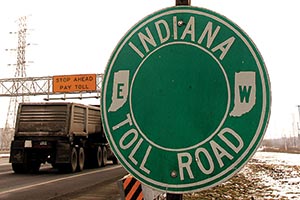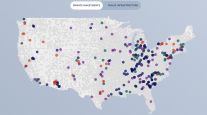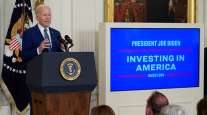More States Consider Tolls to Finance Infrastructure

Rhode Island’s bold move to build the nation’s first truck-only tolls is far from the only action contemplated on the tolling front among the 50 states.
Arizona is mulling them on a freight-heavy route that runs less than 30 miles. Connecticut is considering bringing them back in a big way after a 27-year absence. Indiana and Illinois are talking about adding them to major freight-carrying highways.
Wisconsin is studying them, and there’s even talk about them in sparsely populated Wyoming.
Tolls may be added on new or reconstructed federal highways, bridges or tunnels and on new lanes on existing highways, and the renewed interest in them has largely come from the five-year FAST Act, which became
federal law in December. The law ordered states that have slots in the 18-year-old unrestricted federal pilot tolling program — Missouri, North Carolina and Virginia — to use them or lose them this year.
In response, North Carolina is considering tolling Interstate 77 in the Charlotte area in the wake of a vote by its regional transportation planning commission. Virginia will likely relinquish its slot after Gov. Terry McAuliffe and key legislators came to an agreement on Feb. 10 to add a high-occupancy lane on I-66 inside the Capital Beltway while dropping a proposed toll there.
In Missouri, a member of the House of Representatives has proposed a bill that would allow a public-private partnership to rebuild I-70 with money from tolls, a concept that Gov. Jay Nixon has endorsed.
Indiana, Illinois and Connecticut are among the states that might grab the slots if they become available, according to state officials.
“When people’s hopes for [a federal fuel-tax hike in] the FAST Act weren’t realized, that moved the focus back on the states,” said Neil Gray, director of government affairs for the International Bridge, Tunnel and Turnpike Association.
“Tolling is no one’s first option. It’s not an easy road to travel down. Like them or not, toll roads are subject to intense amounts of public scrutiny,” Gray said.
Which is why Indiana House Roads and Transportation Committee Chairman Ed Soliday faces opposition for merely suggesting studying tolling the state’s major highways, Interstates 65 and 70, as part of his bill that increases the fuel tax by about 4.5 cents per gallon. Indiana’s annual transportation funding shortfall has been estimated as high as $1 billion.
“At the rate we’re tolling the Indiana Toll Road [which runs across the state’s northern tier from Illinois to Ohio], we’re talking about $365 million a year on I-65 and I-70,” said Soliday, whose bill passed the House 61-36 and is being considered by the state Senate, although it is opposed by Gov. Mike Pence.
“Those roads are [mostly] two lanes [in each direction]. They’re not in great shape and have our highest maintenance costs. If we toll those roads, we could go border to border, east to west, north to south with [a total of] six lanes and maintain them in perpetuity,” Soliday said.
Indiana’s diesel and gasoline taxes haven’t increased since 1988 and 2002, respectively.
“I know what the numbers are to take care of our roads,” Soliday told Transport Topics. “How we get there I’m willing to negotiate, but we can’t run an economy without good infrastructure.”
In contrast to Pence, Illinois Gov. Bruce Rauner has proposed a public-private partnership to add at least one lane in each direction on Interstate 55 between I-90/94 and I-355 in metropolitan Chicago.
“We think it’s a win-win-win in terms of relieving congestion, increasing our economic competitiveness and furthering growth,” Rauner said Feb. 4 in announcing his $425 million project, which could include tolls. He said he hopes construction will begin next year.
Matt Hart, executive director of the Illinois Trucking Association, said the state’s transportation system has failed to keep up with its growth.
“With the exception of the Illinois Tollway [286 miles across the state’s northern half], we’ve added minimal capacity,” Hart said. “There has been a lack of political will to raise the motor fuel tax, so people look at other options like a managed toll lane.”
Connecticut removed its last tolls in 1989, but in January its Transportation Finance Panel recommended bringing them back on most of the state’s major roads as part of a 30-year, $100 billion package that would hike fuel taxes — unchanged since 1997 — 14 cents over the next seven years.
Gov. Dannel Malloy and some state legislators are working on a plan to devote all revenue from the fuel-tax increases to transportation spending.




